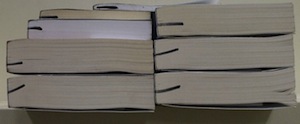
Credit: public domain
Before we can define what a remainder mark is and how it affects the value of a book, we must first define a remaindered book.
What is a Remaindered Book?
A remaindered book is an unsold book that has been returned by a bookseller to the publisher for a refund. When a particular title isn’t moving off the shelves and the bookseller wishes to make room for a title that will sell better, the bookseller can return the remaining copies of the low-selling title to its publisher and get the money back.
Sometimes, in cases where supply far exceeds demand, the books may never have even left the publisher’s warehouse. These are, for all intents and purposes, still brand new books.
Where do Remaindered Books end up?
These books are known as remaindered books and they end up in the “secondary” book market (even though they are technically not used books), in the form of wholesalers, discount and outlet bookstores, independent bookstores, and even on the shelves of retail stores that do not specialize in books (e.g. Target, Wal-Mart, etc).
What kinds of books get remaindered?
For the most part, hard cover editions and some trade paperback editions get remaindered; while unsold mass market paperback editions will simply be destroyed (and hopefully recycled).
What is a Remainder Mark?
A remainder mark can be made with permanent marker, rubber stamp, ink spray, or by various other means, and most typically appears on the bottom page edge of the text block. A remainder mark can be put there either by the publisher, before being redistributed to a secondary seller, or by the secondary seller itself.
You might be asking yourself: Why? Why deface a perfectly good book? When a publisher redistributes a title to discount sellers, those sellers pay the publisher a discounted rate. Thus the books are marked as such.
For example, if a new title sells for $34.99, the bookseller might pay the publisher $19.99 for each book, making a fifteen dollar profit on each copy sold. If the book failed to sell at that price, the remaining copies will be acquired by a wholesaler or discount store for a lesser price, and sold for an even lesser price.
By this time, the mass market paperback of the same title will likely also be on the shelves, so the only incentive for the consumer to purchase a remaindered book is usually that it is less expensive than the mass market paperback.
Is there any value to purchasing remaindered books?
Book lovers tend to consider remaindered books a bane to book collecting. And with good reason. Essentially, they are indeed defaced books. But this doesn’t necessarily mean there is never an instance in which a remaindered book is a good purchasing option.
If your purpose in purchasing a book is to use it as a reading copy—one that you expect will endure a great deal of wear—then a hard bound remaindered book will very likely have a longer lifespan than a mass market paperback.
Occasionally, some remaindered books are signed by the author. This happens (albeit not too often) when an author has a book signing and additional books are signed and set aside at the bookstore to be sold later, and they don’t sell. In cases such as these, a remaindered copy, signed by the author, might have collectible value.
The other copies will end up being returned to the publisher and later resold somewhere else, at a discount. Is your copy a signed book that has been defaced? Yes it is. But does it have more collectible value than an unsigned copy of the same quality? Yes it does.

Leave a Reply